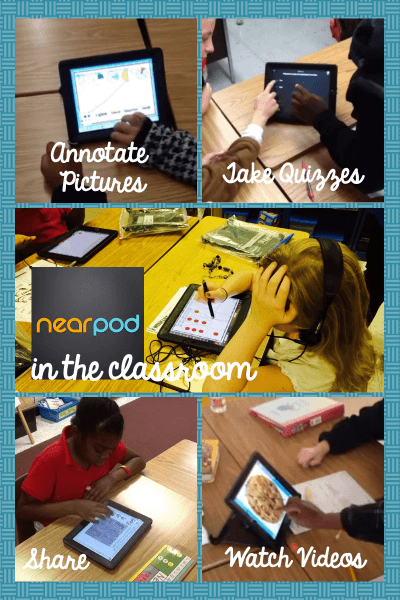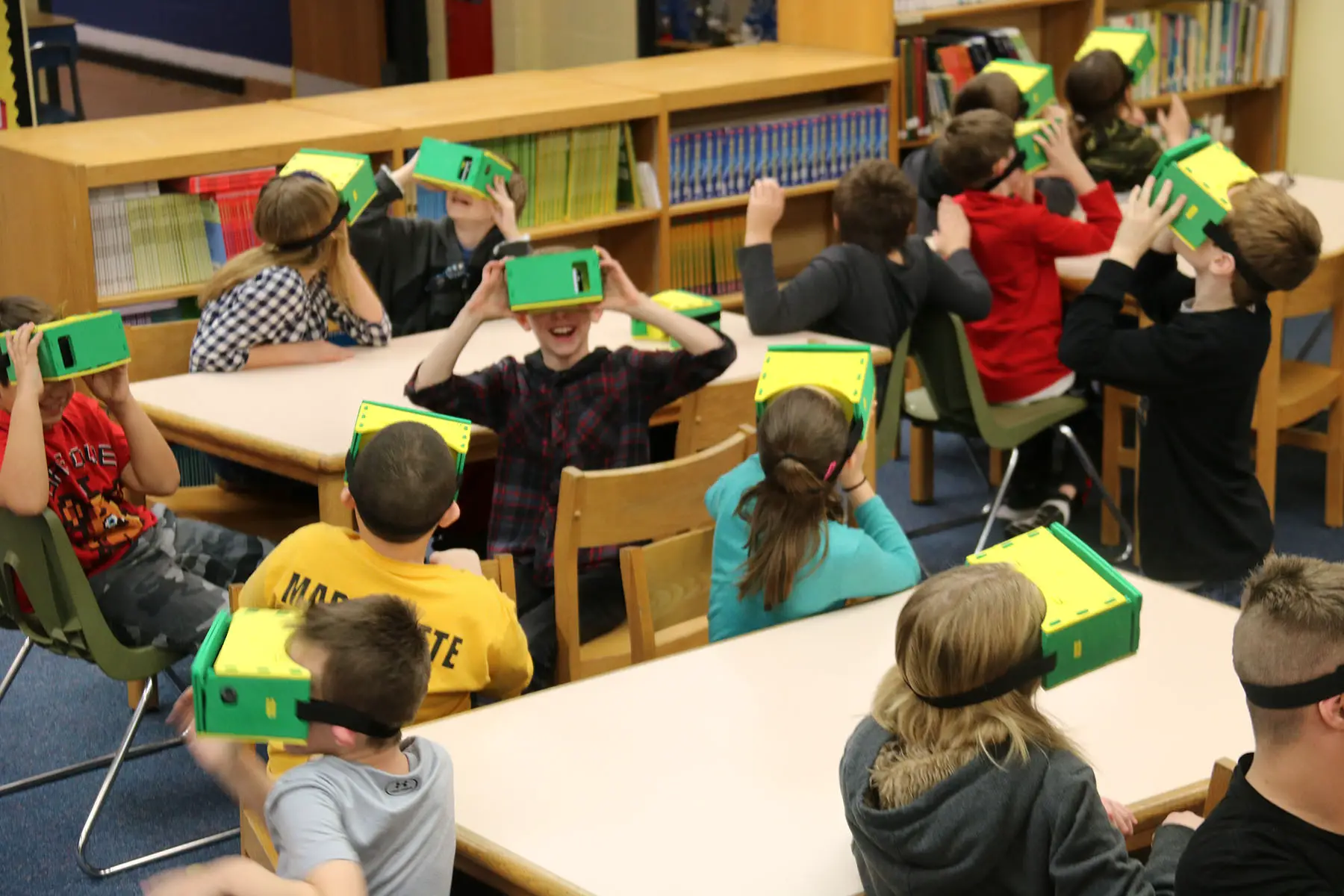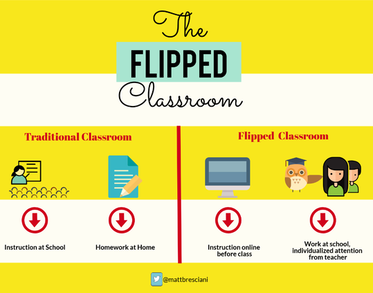Nearpod is an app that is an engaging and interactive for students,
it is a platform that presents material from the teacher. Nearpod is a free
app, however, some of the features are lost the longer that it is used. It
allows for teachers to sync to student devices so that students will see
exactly what the teacher wants them to. The app allows for there to be live
lessons or for lessons to be student paced. Teachers can create their own
lessons or use one of the thousands of ready to teach lessons that are already
provided. Nearpod has lessons from Kindergarten to Twelfth grade. Lessons can
be made to suit individual student needs, which is a huge help to the teacher
and student. Nearpod is compatible with Google Slides or PowerPoint; a teacher
can create their own Google Slide or PowerPoint and drop it into Nearpod.
Teachers are also able to add web content to Nearpod by simply copying and
pasting the URL. Nearpod also allows for teachers to add activities to lessons
so that they will be interactive. An awesome feature of Nearpod is the
Collaborate Board. The Collaborate Board allows for students to comment, and
what makes this feature even better is that the teacher approves the comments.
This will allow teachers to see if the comment is relevant and appropriate.
Another cool feature of Nearpod is Draw Its. Draw Its allows students to draw
pictures, create and use graphic organizers, etc. The Draw Its feature tends to
work better when using an iPad rather than a computer, because students can use
their fingers instead of a mouse. In addition to those features there is also
the feature where teachers can create assessments. The types of assessments
that Nearpod has are: open-ended questions, fill in the blank questions, and
quizzes. A neat thing about the quizzes on Nearpod is that they can be put
directly into the slides and the students can complete them throughout the presentation.
Nearpod is a great tool to have in the classroom. The teachers and students are
both involved with the use of Nearpod. I will be using Nearpod in my future
classroom to allow students to work at their on pace with a lesson.
Sunday, November 17, 2019
Virtual Field Trips
Virtual Field Trips are a wonderful asset to have in the
classroom. Students and teachers are able to travel the world from the inside
of the classroom walls. Students are completely engaged when involved in
virtual field trips. Going on virtual field trips allows for students to visit
places that they may not be able to otherwise. There are many virtual field
trips that can be found on Google with lessons that are attached to them. A
variety of virtual field trips have standards that are aligned to them, which
is a bonus for teachers. Most of them can be found online for free. A benefit
of going on a virtual field trip is that students can complete them at their
own pace. They are a safe alternative to going on an actual field trip.
Students can experience many different cultures when involved with virtual
field trips, which allows them to see the world in a different light. They do
not replace a real life field trip, because the students would not be able to
use their senses to fully experience the place. However, they have been proven
to improve student learning and understanding. Many students tend to talk and
worry about what their friends are doing when they are on an actual field trip,
so going on a virtual one allows for them to really see the content side of
things. Virtual field trips can also be used for social/emotional development,
because students can see things from a different perspective. Students can
visit places that historic people lived in/what they experienced which will
help them to see things from that persons point of view. ClassFlow is a website
that can be used to create a virtual field trip for students to experience. Skype
is another great way for students to go on a virtual field trip. Students can
talk to someone through Skype and see what they see from anywhere around the
world. Google Sites has over 100 virtual field trips that can be used in the
classroom, including national parks that students can visit. I will definitely
use virtual field trips in my classroom one day to enhance student learning.
All Things Digital Literacy with Podcasting
A podcast is a series of digital audio files that can be
used to benefit a classroom. Podacasts are considered language arts but they
have technology integrated. They are similar to talk radio, but they are
available on demand. They are offered through many different platforms
including Soundcloud, anchor.fm, Podiant, Buzzsprout, etc. Podcasts can be used
to support students in the classroom that have various needs. Students could
listen to the podcast at their own pace which would be so beneficial to student
learning. There are multiple different student uses for podcasts. They can be
used to guide, supplement, review, have an augmented lessons, and required
listening. Podcasts can be used to guide
students through various activities, supplement a video or lesson that has been
previously taught, and they can be used as a review and/or study tool. Teachers
could prompt students to demonstrate their learning by allowing them to create
their own podcast. I think that a neat way that I would integrate podcasts into
my future classroom would be to have students do an interview type podcast
where one student asks an essential question and the other students talk about
the topic and state their opinions to answer the question. This would be an
excellent way for teachers to assess what students have learned, and the
students would be able to hear multiple responses to questions to broaden their
thoughts and deepen their understanding. I also think that having students
listen to podcasts that relate to what they are learning will increase their
understanding of the topic. Pinna is a website that has multiple podcast that
are available to students. It is a very kid friendly resource that would allow
students to have various choices in what they wanted to listen to. There are also many podcasts out there that
are available to teachers. Teachers can listen to podcasts to deepen their
understanding of the many different things that come with education. Teachers
could learn about content, students, classroom management, etc. through the use
of podcasts. I will definitely be listening to more podcasts in the future so
that I can learn more about education.
Building a Professional Learning Network
A professional learning network is a group of people that
someone connects with to learn their ideas, questions, reflections, etc. Being
a part of a professional learning network gets us as teachers outside of the
four walls of our classrooms, and it allows us to connect with other educators.
Some of the tools that can be used to build a professional learning network
are: YouTube, Pinterest, Twitter, and Google Plus. As educators, we realize
that education is constantly changing. One way that we can see how to roll with
the changes is by having a professional learning network. Nineteen to thirty
percent of teachers quit within their first five years of teaching. Three
percent of first-year teachers believe that they receive appropriate supports.
If a teacher receives mentoring, collaboration, and extra resources, then the
first-year turnover is cut by more than half. When a teacher has a professional
learning network, they can grow as professionals with the support from a
diverse network of people and resources. Teachers can expand their connections,
seek help, find an emotional support group, and gain a large amount of
professional knowledge anywhere and at any time when they are using their
professional learning network. To build a professional learning network there
are a few simple steps that can be taken. Creating a Twitter page that is
focused on following educators, building a circle of connected educators on
Google Plus, following education blogs and chats, and joining education groups
on Facebook are just a few that will get someone started. Most teachers use
social media for their professional learning networks, they use them to get
themselves out there and learn from others. I will be using a professional
learning network in the future. I will use it to share my own ideas to help
others in there classrooms. I will also be using a professional learning
network gain expertise and knowledge from other educators in order to better my
own teaching and classroom. I think that following education groups on Twitter
and Facebook will most likely be the way that I will learn from others
professional learning networks.
Whole Brain Teaching
Whole brain teaching, also known as power teaching, is a
form of teaching that uses the whole brain. The founder of whole brain teaching
is Chris Biffle, and the co-founders are Chris Rekstad and Andrea Schindler. Whole
brain teaching uses the visual cortex, Wernicke’s area, Broca’s area, motor
cortex, and the limbic system. The goal of whole brain teaching is “to create
peaceful classrooms full of orderly fun.”
The benefits of using whole brain teaching in the classroom are that it:
stimulates and motivates struggling learners, helps teach English Language
Learners, uses the whole brain, helps students with behavior, and it promotes
physical health. The hand movements that are used for whole brain teaching help
students to retain information. This method of teaching also helps students
because when students are engaged they are less likely to have disruptive
behaviors. Whole brain teaching helps meet basic needs, reduces stress, and
increases learning. One strategy that whole brain teaching uses is the
scoreboard strategy. The way that a scoreboard works is that when the students
do something that makes the teacher happy, they get a smiley face. If the
students do something that does not make the teacher happy, they receive a
frowny face. If the students win then they receive a reward for that day, such
as, an extra minute of free play. If the teacher wins then the students receive
a consequence, such as, losing a minute of free play. Another strategy that
whole brain teaching uses is “Teach, Okay”. For “Teach, Okay”, the teacher in
the classroom has students to mirror him/her and then says, “Teach, Okay”. The
students then face each other and one student teaches their friend while the
other student mirrors, after the one teaching finishes the students switch
places. There are also rules that are associated with whole brain teaching. The
rules are as follows:
1.
Follow directions quickly
2.
Raise your hand for permission to speak
3.
Raise your hand for permission to leave your
seat
4.
Make smart choices
5.
Keep your dear teacher happy
I think that I will probably use the rules of whole brain
teaching in my future classroom. I think that students want to make their
teacher happy, so the last rule would be great to use in a classroom.
Flipped Classroom Model
Two chemistry teachers started the flipped classroom when some
their students were at home sick. The way that a flipped classroom works is,
the teacher shares a video with content that they would normally be teaching,
and the students in the class watch the video prior coming to class so that
they can be familiar with the content. While students are learning they can
rewind, pause, etc. which allows them to learn at their own pace. The teacher
serves as more of a guide with the flipped classroom model. Students can come
into class with questions about the video. Higher-level students can come in
and know exactly what to do, and lower-level students can watch the video again
and come in with questions. Teachers can
go around and lead learning activities while the students are learning. The
acronym F.L.I.P. stands for F- Flexible learning environment, L- Learning
Culture, I-intentional learning content, and P- Professional Educator. There
are eight different types of flipped classrooms: standard inverted classroom,
micro flipped classroom, discussion oriented, demonstration based, faux
flipped, group-based, virtual flipped, and role reversal. The lessons in a
flipped classroom can be presented as one lesson or a module of lessons. Some
of the benefits of the flipped classroom model are that it helps students that
are struggling, increases student-teacher interactions, works with all ability
levels, changes classroom management, educates parents and why we talk to them,
is a great tool for absent students and teachers, and is compatible with all
learning styles. A few strategies of a flipped classroom are: active learning,
peer instruction, collaboration, problem-based learning, class discussions, and
inverted classroom (regular flipped classroom). Parents love the flipped
classroom model because they can see exactly what their child is learning and
where they should be in their learning. One great thing about the flipped
classroom model is that the teacher can spend extra time with the students that
need more assistance. This is how I would use the flipped classroom model in my
future classroom. I would use it to be able to help the students that needed
extra help with particular content.
Conscious Discipline
Conscious Discipline helps students and adults to respond
from the higher parts of the brain instead of react from the lower parts of the
brain. It is a relationship-based model of discipline. The students have to
communicate their emotions to one another to resolve any issues rather than the
teacher solving the problems for them. An example of using conscious discipline
would be, if a student hits another student and the student that was hit comes
to tell the teacher, the teacher would tell the student that was hit to tell
the student that hit them that they did not like being hit because it hurt
them. This form of discipline encourages students to communicate their emotions
instead of reacting in a negative way. Conscious Discipline also shows students
how to deal with confrontation instead of avoiding it. When people are not
shown how to deal with confrontation, they will either avoid it all together or
confront others in unconstructive manner. Another benefit of conscious
discipline is that it promotes respect among students in the classroom and in the
real world. When using conscious discipline in the classroom it is important
that the students feel safe. One strategy of conscious discipline is the “safe
place”. The “safe place” is a place where students can go to calm down and
choose how they are feeling. Students can use the “safe place” to read books
about the emotion that they are feeling and see how they want to deal with that
emotion. Another strategy that Conscious Discipline uses is deep breathing.
Students can do this when they are upset to calm themselves down, but teachers
can also use it when students are getting out of hand and he or she wants to
make them refocus. One strategy from Conscious Discipline that I will be
implementing in my future classroom is the Choice Board. The Choice Board is a
board that has different ways for students to choose how they want to be greeted
when entering the classroom. Some of the choices on the Choice Board include:
handshake, hug, high-five, wave, fist bump, and smile. I will be using the
Choice Board in my future classroom because it builds relationships between the
students and the teacher. It also starts the day with a positive attitude, and
can be a do over from the day before. We never know what a student could be
dealing with at home, and starting their day with a positive interaction and
showing them that they are loved is so important.
Subscribe to:
Comments (Atom)










